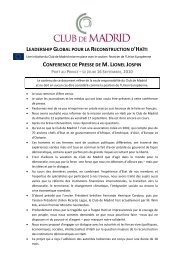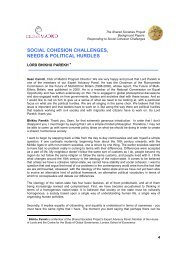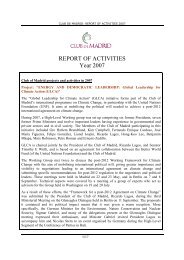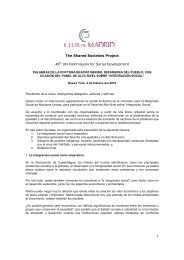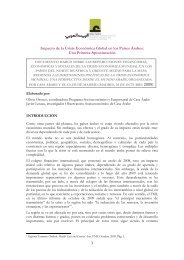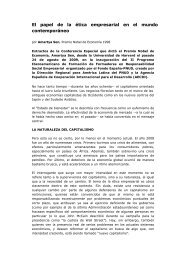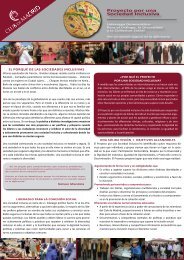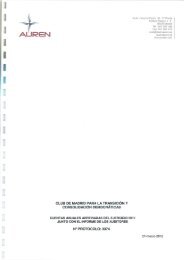Investing cultural diversity and intercultural dialogue - Business and ...
Investing cultural diversity and intercultural dialogue - Business and ...
Investing cultural diversity and intercultural dialogue - Business and ...
Create successful ePaper yourself
Turn your PDF publications into a flip-book with our unique Google optimized e-Paper software.
14 . PART II – KEY VECTORS OF CULTURAL DIVERSITY<br />
promotion of <strong>cultural</strong> <strong>diversity</strong>, a case can be made for<br />
the development of a translation policy on a global scale.<br />
L J.K. Rowling's Harry Potter<br />
books in Italian, German,<br />
Spanish, Catalan <strong>and</strong> Czech<br />
translations<br />
There is a need to<br />
both preserve<br />
global linguistic<br />
<strong>diversity</strong> as a<br />
prerequisite for<br />
<strong>cultural</strong> <strong>diversity</strong><br />
<strong>and</strong> to promote<br />
multilingualism<br />
<strong>and</strong> translation in<br />
order to foster<br />
inter<strong>cultural</strong><br />
<strong>dialogue</strong><br />
Multilingualism, translation <strong>and</strong> inter<strong>cultural</strong> <strong>dialogue</strong><br />
Multilingualism (i.e. the ability to use several languages)<br />
fulfils the dual function of facilitating communication<br />
between individuals of different cultures <strong>and</strong><br />
contributing to the survival of endangered languages.<br />
Translation for its part serves as a necessary bridge over<br />
the many linguistic divides that multilingualism is not<br />
able or available to span. Both are necessary<br />
components of a pluralistic society.<br />
Multilingualism in schools is now practised in many<br />
countries, where national educational objectives have<br />
made social cohesion one of the priorities of public<br />
investment in education. Language policies that support<br />
multilingualism, language learning <strong>and</strong> endangered<br />
languages are indispensable to the long-term<br />
sustainability of <strong>cultural</strong> <strong>diversity</strong>.<br />
Major imbalances in translation flows worldwide reflect<br />
global asymmetries in the representation of cultures,<br />
peoples <strong>and</strong> languages. Data compiled by the Index<br />
Translationum show that 55 percent of all book<br />
translation is from English, as compared with 6.5 percent<br />
into English. The hierarchy between majority <strong>and</strong><br />
minority languages determines translation flows;<br />
translations from <strong>and</strong> into indigenous languages hardly<br />
exist. While literary translation has declined, technical<br />
translation – with English as the predominant source<br />
language – in the major industrialized countries is<br />
increasing. Automatic translation systems, which are also<br />
on the rise, still largely serve the major source or target<br />
languages. Given the important role of translation in the<br />
Generally speaking, language policy <strong>and</strong> planning are<br />
only just coming to terms with the social transformations<br />
of the last decades of the 20 th century. To ensure the<br />
continued viability of the world’s languages, we must<br />
find ways both to safeguard linguistic <strong>diversity</strong> by<br />
protecting <strong>and</strong> revitalizing languages <strong>and</strong> to promote<br />
multilingualism <strong>and</strong> translation by developing policies at<br />
the national level that foster the functional use of all<br />
languages in society. These two objectives are<br />
intertwined since the promotion of multilingualism that<br />
includes mother-tongue education also constitutes a<br />
means of safeguarding indigenous <strong>and</strong> endangered<br />
languages. On the international level, this translates into<br />
a two-pronged approach: 1) to preserve global linguistic<br />
<strong>diversity</strong> as a prerequisite for <strong>cultural</strong> <strong>diversity</strong> <strong>and</strong> 2) to<br />
promote multilingualism <strong>and</strong> translation (including in<br />
administration, education, the media <strong>and</strong> cyberspace) in<br />
order to foster inter<strong>cultural</strong> <strong>dialogue</strong>.<br />
L A sign outside a school in<br />
Dar Es Salaam, Tanzania



